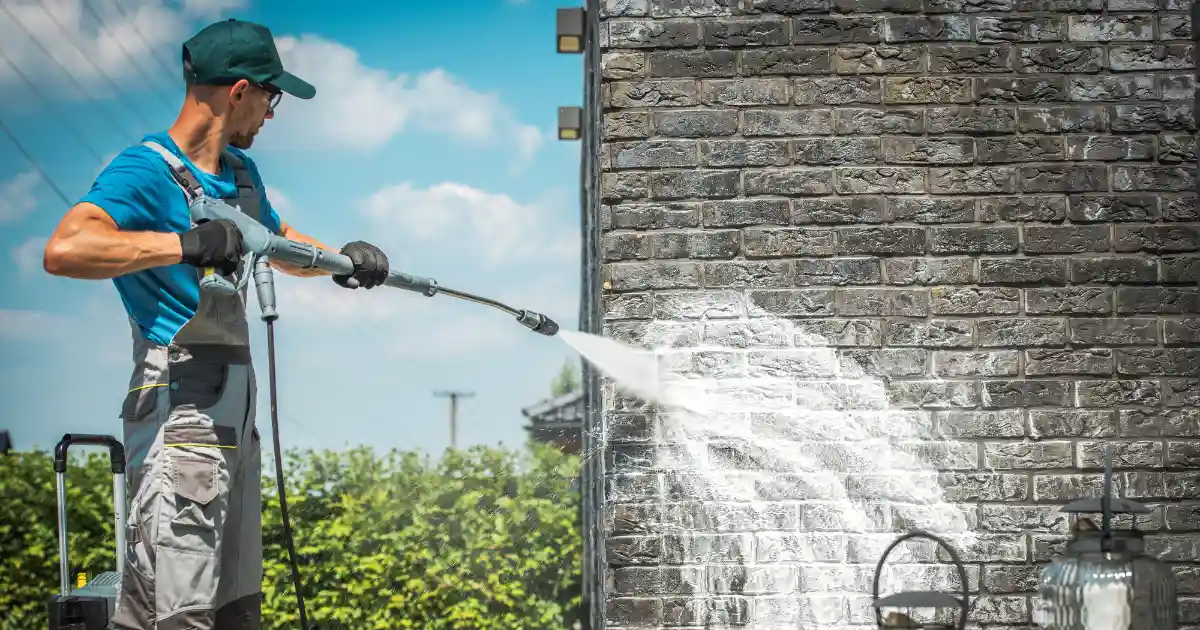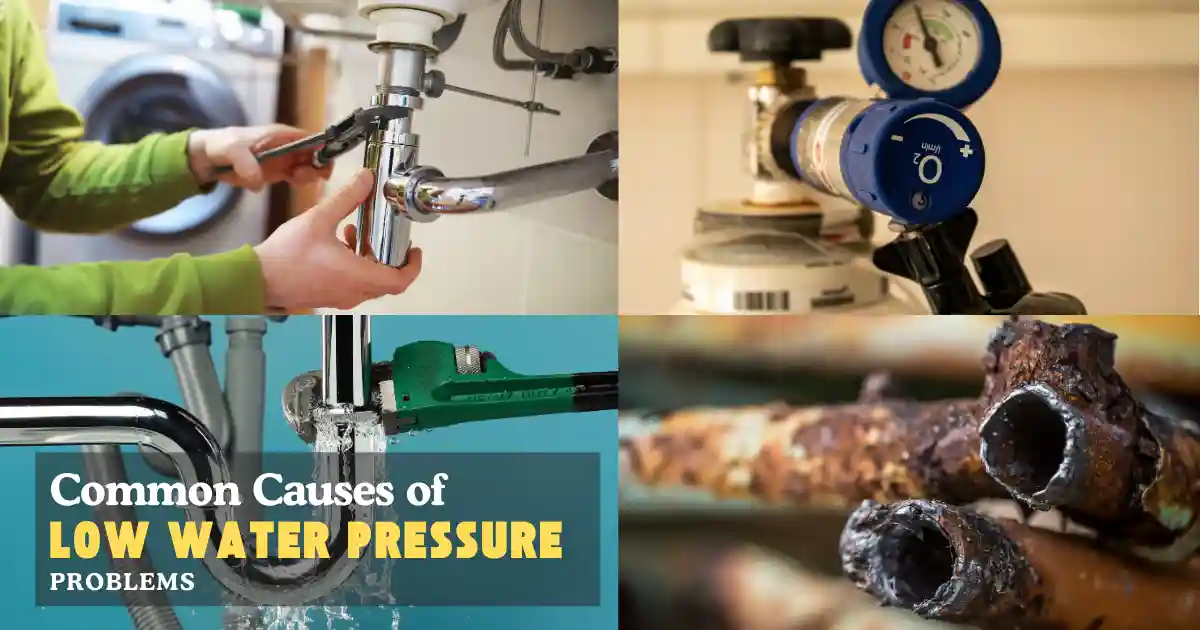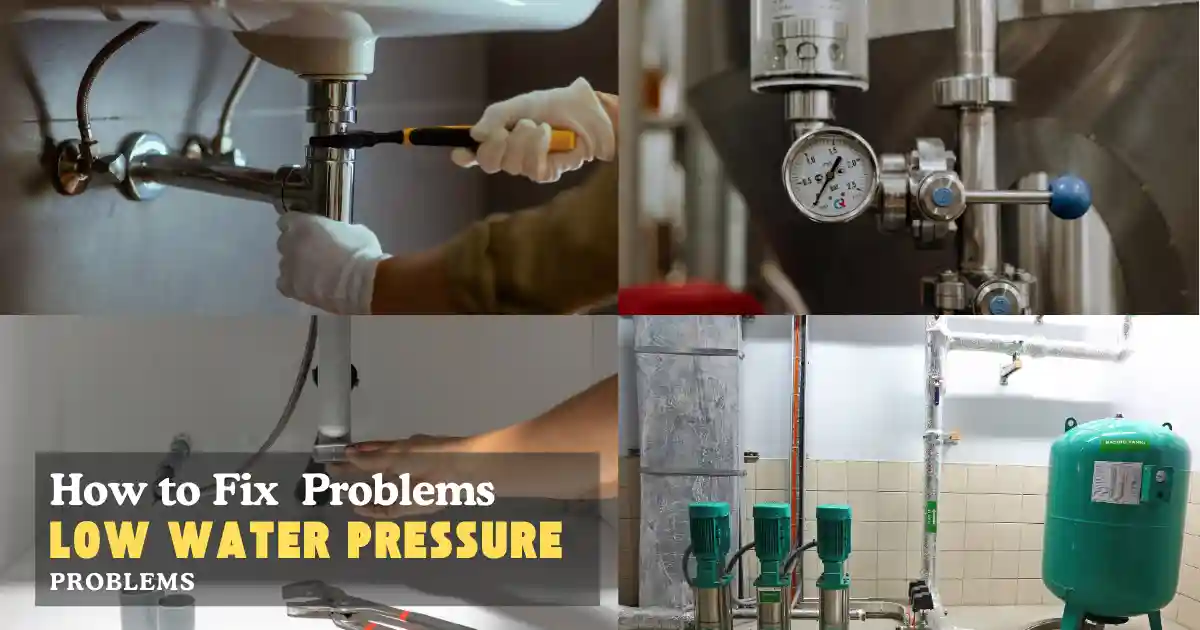The pressure of water is something that most homeowners overlook until it’s gone. If you’re experiencing an ineffective shower, a low filling washer, loud pipes, low water pressure can be very frustrating and often indicate bigger problems. This thorough guide will allow you comprehend the root of low water pressure issues, how to address them, and when you know it’s time to contact an expert.
What Is Water Pressure and Why Does It Matter?
Pressure of water refers to the force used by water that pushes water down your pipes, and out of your showers, faucets and other appliances.

Significance:
- Provides a steady, strong flow of water for showers for washing, cleaning, and showers.
- Influences the performance of appliances (dishwasher washer, dishwasher and so on).
- Leaks can indicate low pressure or plumbing problems.
- High pressure can cause damage to pipes and fixtures.
Normal pressure of water for homes:
- Typically, it is 40-60 Psi (pounds for each square inch)
- The pressure below 40 psi is deemed to be low water pressure. Anything over 80 psi is considered to be too high.
Real life Example:
A couple living in a two story home discovers that their upstairs shower has a weak flow and the kitchen sink flows good. It could be an indication of low water pressure caused by an elevation, or perhaps a partial blockage within the line of supply.
Cost of Low Water Pressure Repairs by Type
| Problem Type | DIY Repair Cost | Professional Repair Cost |
| Cleaning Fixtures | $0 – $50 | $75 – $150 |
| Replacing PRV | $40 – $120 | $200 – $400 |
| Leak Repair | $20 – $100 | $150 – $1,000+ |
| Pipe Replacement | $100 – $500 | $500 – $3,000+ |
| Booster Pump Install | $150 – $400 | $800 – $2,000 |
Costs are based on problem extent, material and the region.
Cost of Low Water Pressure Repairs by Home Size
| Home Size | Minor Repairs | Major Repairs |
| Apartment/Condo | $50 – $200 | $300 – $1,000 |
| Small Home | $80 – $300 | $500 – $1,500 |
| Medium Home | $120 – $400 | $800 – $2,500 |
| Large Home | $150 – $600 | $1,500 – $4,000 |
More large homes and massive damage will increase costs.
Factors Influencing Low Water Pressure in Your Home
- Material and Age of Pipes: Older, corroded pipes block flow.
- Pipe size: Narrow pipes reduce pressure in result of low water pressure.
- The Elevation of a Home: Homes on hills or higher floors could be prone to lower pressure.
- Municipal Supply: Water pressure in cities may fluctuate.
- Peak Usage Pressure decreases when a lot of houses use water at the same time.
- Leaks: Leaks that are even small can result in significant loss of pressure.
- Setting Pressure Regulator: Incorrect settings can result in high or low water pressure.
- Water Quality: Hard water can cause mineral buildup, which can lead to blockages.
6 Common Causes of Low Water Pressure Problems

1. Clogged Pipes or Fixtures
Symptoms:
- Low pressure at any of the fixtures.
- The flow of water from faucets is slow or showerheads.
Causes:
- Mineral buildup.
- Rust or debris in pipes.
- Showerheads that have aerators blocked or clogged.
How to Fix:
- Clean and wash aerators as well as showerheads using vinegar.
- If you have persistent blockages you can flush pipes or contact the plumber.
Example:
A bathroom faucet that isn’t producing enough flow might just need to have the aerator to be cleaned. If the issue is all over the home your main line of supply could be blocked in part.
2. Pressure Regulator (PRV) Issues
Symptoms:
- Rapid drop or increase in pressure across the entire house.
- Banging sounds or noisy pipes.
Causes:
- A misaligned or defective pressure-reducing valve (PRV).
How to Fix:
- Find the PRV close to the primary water source.
- Change the screws to boost or lower pressure.
- Replace the PRV in case it’s defective.
Example:
If the pressure in your home suddenly drops, you should check the PRV that is near the primary water supply.
3. Leaks in the Plumbing System
Symptoms:
- Unforeseen drop in pressure.
- Mold, wet patches or water destruction.
- More expensive water bills.
Causes:
- Leaking pipes, joints, or fixtures.
How to Fix:
- Check the pipes visible as well as walls and ceilings for leaks.
- Utilize a water meter look for leaks that are not obvious (turn off water to all and look to see if the meter changes).
- Repair or replace pipes that are leaking and joints.
Example:
A small leak inside a wall could lead to both water and low pressure damage.
4. Municipal Water Supply Problems
Symptoms:
- The pressure drops at certain times of the day.
- Neighbors face similar problems.
Causes:
- Repairs to the water main in the city.
- Demand for your area is high.
- Municipal pressure changes.
How to Fix:
- Send a report of low pressure that is persistent to your water or city officials.
- Check for planned maintenance and repairs that are scheduled in the area you live in.
Example:
If your entire street is lower pressure than the rest of your street, then it’s most likely an issue with the city supply.
5. Corroded or Old Pipes
Symptoms:
- Pressure loss gradually decreases with time.
- Water that is discolored.
- Numerous leaks.
Causes:
- Mineral buildup and rust in older pipes (especially galvanized steel).
How to Fix:
- Replace old, corroded or unfit pipes with the latest materials (PEX Copper, PEX).
- Change to higher flow fixtures, if required.
Example:
A house that is 50 years old and has original pipes could require the repiping process to resolve low water pressure issue.
6. Shared Supply Lines or Peak Usage
Symptoms:
- Pressure decreases when multiple fixtures are being used simultaneously.
- Low pressure in the morning and late evening peak times.
Causes:
- Water lines shared with neighbors.
- Pipes that are too small.
How to Fix:
- Make use of larger supply lines when it is possible.
- Stagger water use during peak times.
Example:
If the pressure in your shower drops when you run the washer it is possible that your pipes are too small.
How to Diagnose Low Water Pressure Problems
- Are the issues isolated or spread throughout the entire house?
- Make use of a gauge to determine the pressure on an outside water spigot.
- Normal range of water is 40-60 psi.
- Clean and remove aerators and showerheads to look for blockages.
- Look for the presence of mold, wet spots or excessive water bills.
- Replace or adjust PRV if necessary.
- If they’re both experiencing similar issues It’s probably an issue with the municipal level so ask your neighbours also.
- For complex or persistent issues call an expert also.
Pro Tip:
Keep track of times when you feel pressure shifts. This will aid in determining if the problem is a result of time or particular fixtures.
How to Fix Low Water Pressure Problems

1. Cleaning or Replacing Fixtures
- Clean showerheads and aerators and soak them with vinegar in order to dissolve the mineral buildup.
- Repair or replace damaged or old fixtures.
- Make use of a toothpick, or a small brush to clean the debris.
2. Adjusting or Replacing the Pressure Regulator
- Find the PRV near the principal water supply.
- Change the screws to boost or reduce pressure.
- Replace the PRV in case it’s defective.
3. Finding and Repairing Leaks
- Examine visible pipes as well as walls and ceilings for leaks.
- Make use of a water meter to find leaks hidden (turn off water to all and check if the meter is moving).
- Repair or replace leaky pipes and joints.
4. Upgrading Pipes or Fixtures
- Replace old, corroded or over-sized pipes with new materials (PEX or copper).
- Switch to fixtures with high flow, if required.
5. Connecting to Your Water Service
- Inform the water company of persistent low pressure. your water or city officials.
- Check for planned maintenance and repairs for your local area.
6. Installing a Booster Pump
- In homes that have always low pressure the booster pump may boost the flow.
- Professional installation is recommended.
When to Worry: Signs of Serious Water Pressure Issues
- A sudden, mysterious decrease in pressure.
- Mold, water stains or wet spots that appear on ceilings or walls.
- Rusty or discolored water.
- Pipes that sound raucous (banging or whistling hitting).
- Numerous leaks and frequent repair.
- Pressures over 80 psi (can cause damage to pipes and appliances).
- If you spot these symptoms, contact an authorized plumber right away..
Preventing Water Pressure Problems
- Make sure to regularly clean your aerators as well as showerheads.
- Plan annually scheduled plumbing checks.
- Replace pipes that are old in case they break before failing.
- Install an air pressure regulator in the event that you don’t already have one.
- Check the water bills of your household for abrupt rises.
- Insulate pipes in order to stop the pipes from freezing and then bursting.
- Beware of using multiple demand driven fixtures simultaneously.
Pro Tip:
Install a complete home monitoring system to monitor water levels for early leak detection as well as alerts for pressure.
Environmental Impact and Water Conservation
- Repairing leaks and maintaining correct pressure conserves water and can reduce your utility costs.
- A high pressure water supply can result in the waste of thousands of gallons a year.
- Low flow fixtures and energy efficient appliances can help save water.
- Intelligent water monitoring warn you of leaks and overuse which can help you save money while also protecting the environment.
Conclusion
The causes of low water pressure issues may range from minor issues to major plumbing issues. Understanding the reasons, knowing how to identify and fix problems and knowing when you should call an expert, you can ensure that your home’s water is flowing effortlessly and save money on repairs. Regular maintenance, quick repairs and smart upgrade are the most important factors to a hygienic plumbing system as well as a cozy home.
FAQs
What is the normal water pressure for an average home?
40–60 psi is the standard for most homes.
Can high water pressure cause issues?
Yes, pressure over 80 psi may cause damage to pipes, appliances, and fixtures.
How can I check the water pressure in my home?
Install a pressure gauge on an outdoor spigot or the laundry faucet to measure your home’s water pressure.
Why does my water pressure drop when I run two fixtures at the same time?
Your pipes might be undersized or you might have a shared supply line.
Can I solve water pressure issues myself?
Small issues such as cleaning aerators can be done yourself, but pipe leaks and replacements should be handled by a professional.
How often should I check my water pressure?
At least once per year, and after any plumbing repairs or renovations.
How can I best prevent water pressure problems?
Maintain a regular maintenance schedule, repair leaks promptly, and upgrade old pipes as needed.
Are there eco friendly ways to improve water pressure?
Yes! Install water-efficient fixtures and repair leaks to save water and maintain good pressure.
Can water pressure issues impact my water bill?
Yes, leaks and inefficient fixtures can increase your water usage and expenses.
When should I contact a professional plumber for water pressure issues?
If you notice sudden drops, multiple leaks, or can’t pinpoint the cause, contact an expert plumber.
